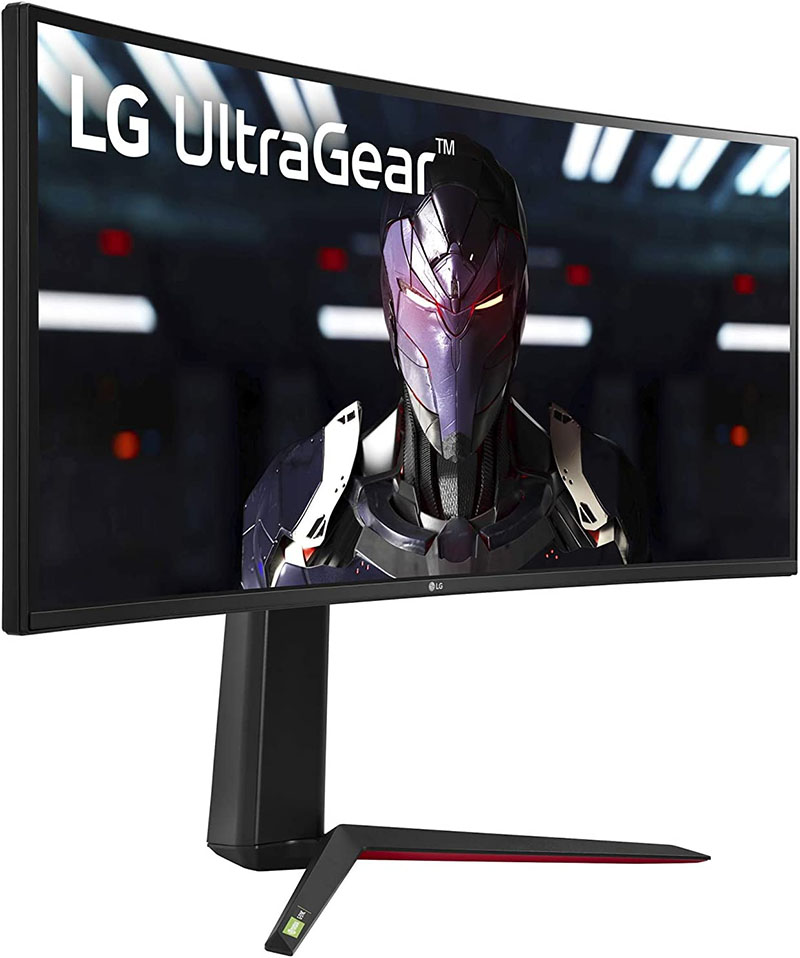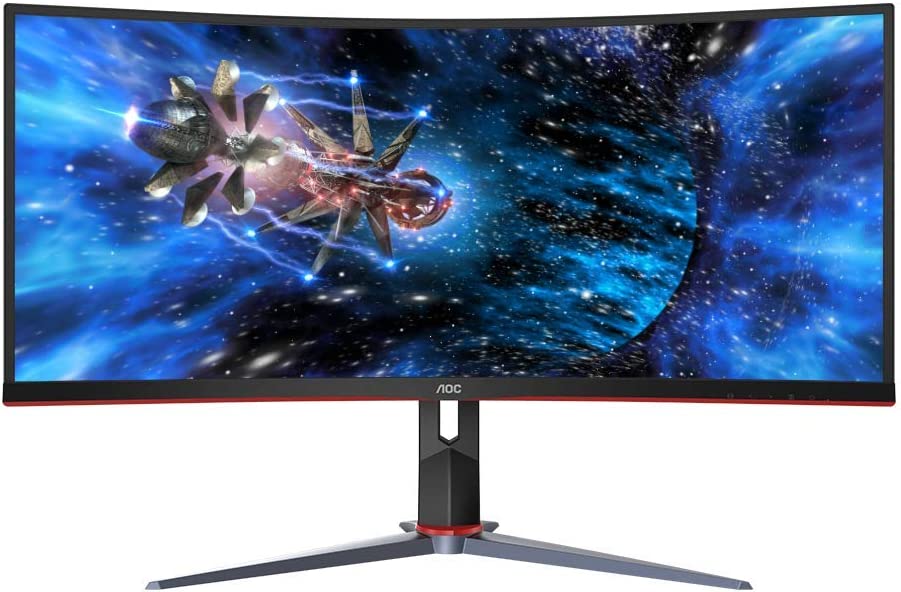The best ultrawide gaming monitors: Immerse yourself
Want to game on a huge, immersive monitor? An ultrawide monitor should be your next display. Ultrawide offers a larger viewing area than a widescreen alternative and a broader perspective that literally displays more in-game content. Today’s best ultrawide gaming monitors also deliver top-tier motion performance and support for the latest adaptive sync standards.
These are the best ultrawide gaming monitors right now.
For recommendations on a variety of monitor sizes at a range of prices, see our roundup of the best gaming monitors.
1. Alienware AW3423DWF – Best ultrawide gaming monitor
Pros
- Excellent contrast ratio
- Top-notch color gamut and accuracy
- Great motion clarity
- Respectable HDR performance
- Extremely competitive price
Cons
- Stand is a bit too large
- No USB-C
- Maximum HDR brightness is lackluster
The Alienware AW3423DWF is an awesome gaming monitor, bringing the incredible contrast and realism of OLED in a 34-inch widescreen panel. Though priced at $1,099—not inexpensive for most people—it’s a better value than most high-end gaming monitors.
The monitor’s excellent image quality provides a vivid, immersive, rich experience with deep black levels and bright highlights. Games seem to leap out of the display, as if you’re looking through a window rather than staring at your computer screen. Gamers who like dark, moody genres, such as horror games, will appreciate the monitor’s ability to reach deep black levels with minimal loss of detail.
This monitor offers an enhanced refresh rate of up to 165Hz and supports AMD FreeSync Premium Pro for smooth frame pacing in games. It also has better-than-average motion performance at lower refresh rates, a benefit of the OLED panel’s fast pixel response times.
The monitor isn’t bright and has a glossy display coat that can reflect light, so it’s best in a dark room. We also noticed the OLED panel has trouble rendering small fonts smoothly. These are minor issues and have less impact on games than other scenarios.
Connectivity is acceptable, with two DisplayPort inputs and one HDMI, and a USB-A hub with four ports. There’s a healthy range of menu options that help gamers change the image quality to their preference.
Read our full
Review Alienware AW3423DWF
2. LG Ultragear 34GN850-B – Best ultrawide gaming monitor under $1,000

Pros
- 21:9 panel with a 34-inch screen
- Curved monitor
- Impressive gaming performance
- Ergonomic adjustment options
Cons
- Only average power consumption
- Expensive
Released in 2020, the LG Ultragear 34GN850-B, was the best ultrawide gaming monitor to debut that year, and only recently defeated by the Alienware AW3423DWF. In response, LG slashed the former champion’s price from an MSRP of $999.99 to $699.99 at most retailers (and it has occasionally sold for as little as $599.99).
Though no longer at the top of its class, LG’s Ultragear 34GN850-B is an attractive monitor with excellent color performance, a high maximum brightness, and good motion performance from its fast “Nano IPS” panel. It looks slightly sharper than the Alienware, despite the fact they both have the same native resolution. The LG is arguably better than the Alienware for mixed productivity and gaming use, as display glare is not an issue and small text doesn’t appear pixelated.
The LG Ultragear 34GN850-B offers an enhanced refresh rate of up to 144Hz (with a 160Hz overclocked mode) and is officially compatible with both AMD FreeSync and Nvidia G-Sync. Its overall motion performance is not as good as the Alienware, but it’s close, and better than budget alternatives like the AOC CU34G2X.
What’s the catch? Contrast. The monitor’s IPS panel has the lowest contrast ratio of the three monitors we recommend here and can look hazy in dark scenes. It looks best in a moderately to brightly lit room, as this makes the lack of contrast less noticeable.
The monitor’s connectivity and features are consistent with high-end monitors: two HDMI ports, one DisplayPort, and a two-port USB hub. A few more USB ports would be appreciated but, at this price, the available options are acceptable.
Read our full
Review LG Ultragear 34GN850
3. AOC CU34G2X – Best ultrawide gaming monitor under $500

Pros
- Gaming monitor in ultrawide 21:9 format
- Impressive gaming performance
- Large 34-inch curved panel
- Ergonomic adjustment options
The AOC CU34G2X is a rare budget-friendly ultrawide monitor, retailing at or below $349.99. It does make a few compromises to reach that price point—but image quality isn’t among them.
The 34-inch ultrawide monitor has a VA panel that provides good contrast and vibrant color performance. Its maximum brightness is a bit low, but similar to the Alienware AW3423DWF in SDR content (the CU34G2X does not support HDR). The AOC monitor offers 3440×1440 resolution, the same as the other monitors on this list, so it looks just as sharp. Gamers who aren’t particular about image quality will find it difficult to tell the difference between this monitor and the more expensive LG Ultragear 34GN850-B.
The AOC CU34G2X is an ultrawide gaming monitor with a refresh rate up to 144Hz, and it delivers solid motion performance. However, it doesn’t officially support either AMD FreeSync or Nvidia G-Sync. Both standards should work unofficially but, because the display is not certified, owners may experience flickering when game frame rates dip too low. Gamers may need to rely on using V-Sync in some titles.
Though the monitor’s image quality is impressive for the price, its aggressive red-and-black design is even more in-your-face than LG’s Ultragear and might turn off some gamers. Material quality is mediocre, as well, so the monitor doesn’t look as premium as the LG or Alienware alternatives.
Connectivity, on the other hand, is excellent, with two HDMI and two DisplayPort and a four-port USB-A hub. That’s the best of any monitor on this list—not something we’d expect from a budget display. The monitor also includes a height-adjustable stand, a perk that budget ultrawide monitors often ditch.
Read our full
Review AOC CU34G2X
What to look for in an ultrawide gaming monitor
Ultrawide gaming monitors are an awesome choice for PC gaming, yet remain a tiny niche compared to far more popular 27-inch and 32-inch widescreen gaming monitors. According to the latest Steam Hardware Survey results, less than 2 percent of all PC gamers on Steam have an ultrawide monitor.
That’s a shame, and limits choice when buying an ultrawide monitor. Still, gamers should key an eye on these features when making a purchase.
Panel type is a big deal
Ultrawide monitors offer IPS, VA, and OLED panels. Each has advantages and disadvantages.
IPS panels are the most common, and for good reason. They display a wide range of color, have great color accuracy, can reach high levels of brightness, and look sharp at any given resolution. However, their low contrast ratio can be a problem for darker games, which can appear hazy and lack detail. IPS panels are best for mixed use in brightly lit rooms.
VA panels are often found in budget ultrawide monitors, though some companies (most notably Samsung) also use them in high-end displays. They have better contrast than IPS panels and deliver similar color performance. VA panels can struggle with motion performance and budget VA panels tend to fall behind IPS in brightness.
OLED is the leader in overall image quality. It provides the best results in color gamut, color accuracy, contrast, and motion performance. Sharpness is often reduced compared to IPS and VA, but most people will find it a minor downgrade. OLED tends to lead in HDR as well: Mini-LED can exceed it in some cases, but few ultrawide monitors use Mini-LED technology.
In general, OLED is better than IPS, and IPS is better than VA. Some gamers might prefer VA over IPS, however, especially when gaming in a dark room.
Refresh rate and pixel response times
All the ultrawide gaming monitors we recommend share a similar refresh rate (between 144Hz and 165Hz). That implies they have similar motion performance, but there’s more to it.
OLED monitors, such as the Alienware W3423DW, have the best motion performance overall. They offer not only a high refresh rate but the lowest pixel response times (often quoted at .03 to .05 milliseconds), which means pixels transition between colors quickly. This reduces motion blur at both high and low refresh rates, giving OLED an edge.
IPS monitors tend to have the second-best pixel response times, with models like the LG Ultragear 34GN850-B quoting response times of one millisecond. VA panels can also achieve one millisecond response times, though some panels may lag this standard.
In summary: look at refresh rate first, then look at pixel response time to compare monitors with the same refresh rate.
Be wary of large ultrawide displays
The only ultrawide gaming monitors we currently recommend are 34-inch ultrawide gaming monitors with 3440×1440 resolution.
A variety of larger ultrawide gaming monitors are available. This includes 45-inch ultrawide monitors like the Corsair Xeneon Flex 45WQHD240 and LG Ultragear 45GR95QE, as well as super-ultrawide monitors like the Samsung Odyssey G9 series.
However, these larger monitors carry high price tags and tend to have issues in overall usability. The larger 45-inch ultrawide options don’t increase resolution compared to 34-inch models, so they can appear a bit soft and pixelated. The 49-inch super-ultrawide models can be a match for hardcore simulation gamers but aren’t widely supported in more mainstream game genres.
Extremely large and super-ultrawide gaming monitors are a niche within a niche. They might be a go-to pick in the future, but for now it’s best to stick with more widely supported 34-inch, 3440×1440 monitors.
Don’t buy an ultrawide for console gaming
Looking to buy a monitor for console gaming? Don’t buy an ultrawide monitor.
None of the current game consoles support ultrawide resolutions. This is true even in games that have a PC release with ultrawide support.
A game console connected to an ultrawide monitor will still display an image, but it will be restricted to the usual widescreen display space, leaving black bars on either side of the screen.
How we test monitors
PC World’s staff and freelance reviewers spend hundreds of hours conducting in-depth testing that compares monitors across a broad range of price points and capabilities, from $100 budget monitors to legendary top-tier displays priced beyond $3,000. We personally test dozens of monitors every year to find the best pick for every category and price point.
We use a SpyderXElite color calibration tool. It delivers objective measurements for a range of metrics including brightness, contrast, color gamut, color accuracy, color temperature, and gamma. These results are logged, which makes it easy for PC World reviewers to compare different monitors. It also eliminates subjective bias—an important point, as differences in room lighting, time of day, and the type of content viewed can easily change a reviewer’s experience.
For all the latest Technology News Click Here
For the latest news and updates, follow us on Google News.
